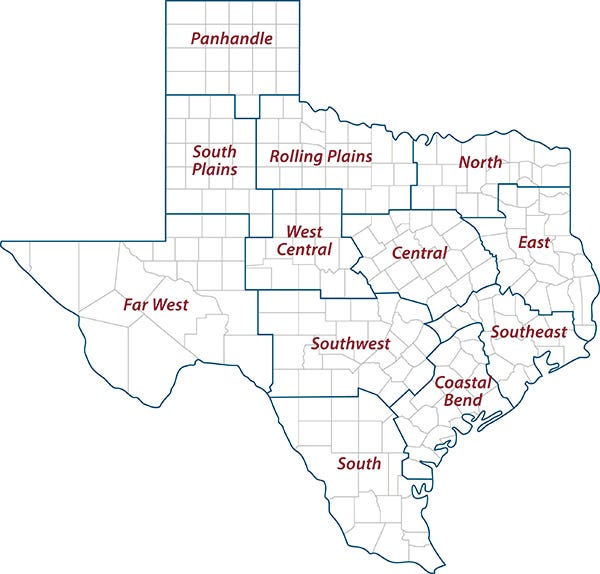
Consumers — and the Easter bunny — may have noticed the price of eggs increasing recently, but that has mostly to do with demand, said David Anderson, AgriLife Extension economist, Bryan-College Station. Anderson said he expects that trend to continue leading up to the Easter holiday.
“We’re actually producing more eggs than we did a year ago, but eggs have a seasonal pattern to them,” he said, “And with Easter being earlier than usual this year, we’re also seeing prices rise earlier than we typically would.”
Producers saw wholesale prices for cartons of shell eggs strengthening through this past week with the increasing demand.
Holidays tend to drive demand up as consumers purchase more eggs than usual for eating and baking. The Easter holiday demand also includes the purchase of eggs to dye and hide.
Egg prices rising but lower than last month
According to the U.S. Bureau of Labor, in February, the Consumer Price Index for eggs increased 5.8%, which was 17% below the level of 2023, with an average price of $3 per dozen. This price was 47 cents per dozen higher than in January.
Egg prices peaked in February at $3.29 per dozen, according to some weekly USDA retail grocery store data, Anderson said.
Last year around the Easter holiday, the U.S. Department of Agriculture – Agriculture Marketing Service reported retail eggs nationally were $2.74 per dozen. Anderson said consumers can expect them to be around $2.99 per dozen this year.
Anderson expects the cost of a dozen eggs will decline around Texas after the holiday, which is typical, however stores may drop prices closer to Easter if demand isn’t as strong as expected.
“But I don’t think I’d wait until right before Easter to buy your eggs, just in case the demand is stronger than expected,” he said. “You probably don’t want to wait too long to get eggs, especially if you’re planning on using real ones for your Easter egg hunt.”
Ongoing effect of avian influenza
Avian influenza, which has devastated commercial and backyard flocks in the U.S. since the outbreak began in January 2022, has been on the decline so far this year. Only one flock in the state has been infected to date, and that was a backyard flock in the Texas Panhandle, said Greg Archer, Ph.D., AgriLife Extension poultry specialist and associate professor in the Texas A&M Department of Poultry Science, Bryan-College Station.
“Since December there have been around 14 million birds lost to avian flu, with the majority being in the upper Midwest,” said Archer. He said while that number may be alarming, the majority – around 11 million — were impacted in December and last month only about 300,000 birds were lost.
Since the start of the outbreak in 2022, over 82 million birds have been affected. As producers have been able to replace the egg-laying hens lost, consumers have seen that reflected in lower egg prices.
“Knock on wood we’ll continue to see those fatality numbers drop,” he said. “Since it hasn’t been as bad this year, I wouldn’t expect egg prices to be as affected by that as much as in past years.”
AgriLife Extension district reporters compiled the following summaries:

CENTRAL
Cooler temperatures were accompanied by substantial rainfall. Winter pastures improved significantly, and the better weather prompted warm-season grasses to break dormancy. Producers were spraying fields, applying fertilizer and managing brush to remove prickly pear and restore native pastures. The cooler temperatures slowed down the development of leaf rust, while wheat conditions showed steady improvement. Moisture posed a risk of stripe rust and other diseases. Hessian flies seemed smaller in number compared to recent years. Corn planting operations neared completion but were delayed by recent rains. Grain sorghum planting also faced delays. Corn showed a promising start with adequate soil moisture and favorable weather conditions. Cattle remained in good body condition, and the local market for calves was favorable. The sheep and goat market remained strong. Stock tank levels remained full. Pastures greened up, reducing the need for supplemental feeding, and stocker cattle gained well on winter grazing. Producers donated significant amounts of hay to support those in the Panhandle affected by wildfires.
ROLLING PLAINS
District-wide rain fell with amounts ranging from 0.5 inch to 2 inches. Farmers who had wheat top-dressed with fertilizer before the rains were especially grateful for the timing of the moisture. Wheat across the district looked very satisfactory, as did stocker calves, which showed excellent body condition thanks to above-average grazing. Pasture grasses and stock tanks were also in good condition. Producers in a few counties began tilling cotton fields.
COASTAL BEND
Widespread rain improved soil moisture, benefited crops and led to the completion of planting in Nueces County. Rangeland and pasture conditions were improving with warmer temperatures and adequate soil moisture. Corn and sorghum planting was completed, and cotton planting was underway. Most planted acres were up and growing, although rangeland and pasture conditions varied from poor to fair, with some areas rated good where pastures were rested. Livestock was generally doing well.
EAST
Recent rain and warmer temperatures continued to aid the growth and green-up of warm-season forages. Producers in some areas could slow or completely stop feeding hay, which helped relieve some of the stress of thin hay supplies. Pasture and rangeland conditions were fair to good. Subsoil and topsoil conditions were adequate. Heavy rain ensured ponds and creeks were full. Cattle market prices were strong and higher in some markets. Livestock were in fair to good condition with some supplementation taking place. Fertilizer prices increased.
SOUTH PLAINS
It was another wet week across most of the district with rainfall totals from 0.5-0.8 inch. Wheat fields were in very good condition. The rain provided much-needed winter grazing for cattle across the district. A few producers sprayed their wheat crop to prepare for the planting season. Cattle were in good condition and supplemental feeding was minimal.
PANHANDLE
The region experienced mild temperatures and no precipitation. Corn, cotton and sorghum preplant activities continued. Wheat was beginning to grow rapidly. Precipitation was needed. Cattle were being supplemented on rangeland. Rangeland and pasture green-up started. Overall, soil conditions were reported to be adequate to short. Pasture and rangelands were reported to be fair to very poor. Winter wheat was reported good to poor. Livestock operators in several counties were beginning the recovery process after the devastating fires that began in late February.
NORTH
Rainstorms brought 1-2 inches of rain over the northeast portion of the district. Topsoil was adequate, and crop conditions for cool-season crops continued to be favorable for growth and development. Noctuid moth populations were increasing. Livestock were in fair to good condition overall. Most counties saw a decline in hay consumption over the last week due to the growth of green grass in the pastures. No diseases were reported.
FAR WEST
Temperatures were steady across the region, with highs in the low 80s to mid-70s. Dry and windy conditions, coupled with the wildfires in the Texas Panhandle, had producers and first responders on high alert as area rangelands had a large amount of fuel available if a wildfire occurred. A cool front entered parts of the region over the weekend and temperatures dropped into the low 50s. There was rainfall from between 0.3 inch and 1.5 inches. Wheat was growing. Producers continued preparing land for cotton crops. Pecan trees started to put on leaves. Land and stock tanks were still very dry and in poor condition. Area cattle producers were busy with the start of spring branding season. Lambing was complete and goats were expected to kid through March. Livestock were in fair condition and producers continued supplemental feeding.
WEST CENTRAL
The district experienced a range of temperatures from the lower 60s to low 80s, accompanied by light rain showers. The rainfall helped replenish topsoil and subsoil moisture, but more was needed to create runoff and improve rangeland and pasture conditions, as well as fill tanks and ponds. Winter wheat was improving and in good condition. Fieldwork continued in preparation for spring planting. Livestock remained in good condition as spring grasses were starting to grow.
SOUTHEAST
The district was swept with rainfall, leaving fields soaking up most of the water. Grass started to green up with the moisture and mild temperatures. Producers were preparing for rice and corn planting. Wheat was being top-dressed. Preparation for cotton planting began. Ponds and tanks were filling up. Livestock were in good condition, and local markets showed a slight price rise for all classes of beef cattle.
SOUTHWEST
Weather conditions continued to be dry, with several days of windy conditions, which increased crop evapotranspiration and soil drying. Overall rainfall reported for the week ranged from 0.2 inch to 2.2 inches, with some areas receiving hail and experiencing cooler temperatures. Farmers were tilling the land in preparation for planting, with a few managing to sow seeds before the rain. Overcast weather for a few days helped alleviate conditions that would have otherwise created additional stress on the crops and soil moisture. The small rain showers did not significantly replenish subsoil moisture but may have initiated some growth in the pastures. Rangeland green-up began with wildflowers blooming. Corn planting was complete, while farmers were waiting for more rain to plant hay and milo. Hay was becoming increasingly scarce and was extremely costly. Spring shearing and late lambing and kidding continued, with livestock mostly in fair condition and under supplementation.
SOUTH
Weather conditions throughout the district were mild with scattered showers over the weekend. Strawberry production was taking place, and corn planting continued. Wheat and oat crops began heading under irrigation. Onions, citrus and cool-season vegetables were being harvested. Watermelons were being planted. Pasture and rangeland conditions were fair. Bermuda grass was greening up. Stock tanks were low. Producers continued supplemental feeding for their herds. Local markets remained strong and steady for all classes of beef cattle.
About the Author(s)
You May Also Like




